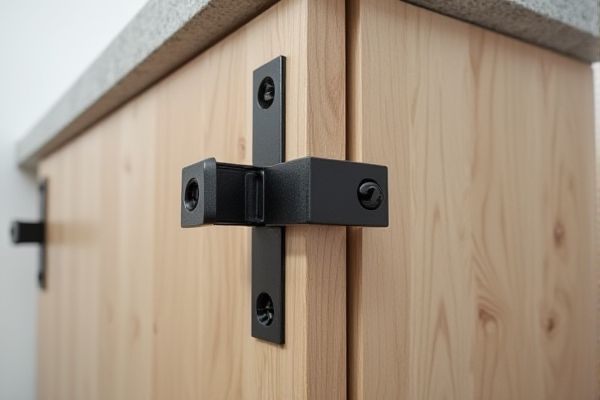
Concealed hinges offer a sleek, modern look by hiding the hardware within the cabinet, enhancing the overall aesthetic and providing adjustable alignment. Explore the rest of the article to understand how your choice between concealed and exposed hinges can impact both functionality and style.
Table of Comparison
| Feature | Concealed Hinges | Exposed Hinges |
|---|---|---|
| Visibility | Hidden from view when door is closed | Visible on door surface |
| Aesthetic | Sleek, modern look | Traditional or decorative style |
| Installation | Requires precise drilling and setup | Simple surface mounting |
| Adjustability | Multi-directional adjustment for perfect alignment | Limited adjustment options |
| Durability | Strong, supports heavy doors effectively | Varies, often less sturdy for heavy doors |
| Maintenance | Less exposed to dirt, lower maintenance | Exposed to elements, may require more upkeep |
| Cost | Generally higher price | More budget-friendly |
| Common Uses | Kitchen cabinets, modern furniture | Traditional furniture, gates, wardrobes |
Introduction to Hinges: Concealed vs. Exposed
Concealed hinges offer a sleek, modern aesthetic by remaining hidden when cabinet doors are closed, enhancing the clean lines of your furniture. Exposed hinges, meanwhile, provide a traditional look and are easier to access for adjustments or repairs. Choosing between concealed and exposed hinges depends on your design preferences and the functional requirements of your cabinetry.
What Are Concealed Hinges?
Concealed hinges are hardware mechanisms installed inside cabinets or doors, remaining hidden when the door is closed to provide a clean and seamless look. These hinges offer adjustable, smooth operation and are commonly used in modern cabinetry for aesthetic appeal and functionality. You benefit from concealed hinges by achieving a sleek design while ensuring durability and easy installation.
What Are Exposed Hinges?
Exposed hinges are hardware components mounted visibly on the surface of doors or cabinets, often adding a decorative or stylistic element to furniture and architectural designs. These hinges typically feature a pin and two plates, allowing easy access for maintenance and adjustments. Popular in traditional and rustic aesthetics, exposed hinges can be made from various materials like brass, steel, or bronze to complement different interior themes.
Aesthetic Differences: Modern vs. Traditional Looks
Concealed hinges offer a sleek, minimalist look that enhances modern cabinetry by hiding hardware inside the door, creating a smooth, uninterrupted surface ideal for contemporary design. Exposed hinges provide a more traditional and decorative aesthetic, often featuring intricate details and finishes that complement classic and rustic styles. Selecting between concealed and exposed hinges significantly influences the overall visual appeal, with concealed hinges supporting clean lines and exposed hinges adding character and craftsmanship.
Installation and Adjustment Comparison
Concealed hinges offer a cleaner aesthetic by remaining hidden when the door is closed, requiring precise mortising during installation for a flush fit, which can be more time-consuming but results in a seamless look. Exposed hinges are simpler to install as they are surface-mounted with visible screws, allowing for quicker setup but offering less flexibility in fine-tuning door alignment. You can achieve easier adjustment with concealed hinges using integrated adjustment screws, providing better control over door positioning compared to most exposed hinge designs.
Durability and Maintenance Considerations
Concealed hinges offer superior durability due to their protection from dust, moisture, and physical damage, making them less prone to wear and tear compared to exposed hinges. Exposed hinges require more frequent maintenance, including cleaning and lubrication, as their components are directly exposed to environmental factors that can cause rust or corrosion. Your choice between concealed and exposed hinges should factor in the ease of upkeep and the lifespan you need for your cabinetry hardware.
Functionality and Application Suitability
Concealed hinges offer superior functionality through their hidden design, providing a sleek, modern appearance ideal for contemporary cabinetry and furniture, while allowing for adjustable fitting and smooth operation. Exposed hinges, often made of robust materials like brass or steel, are suitable for applications requiring strong support and easy maintenance, commonly used in traditional or rustic furniture where their decorative appearance adds character. The choice between concealed and exposed hinges depends on the balance between aesthetic preference and functional requirements, with concealed hinges favored for seamless integration and exposed hinges for durability and ornamental value.
Security Implications of Hinge Types
Concealed hinges enhance security by being hidden within the door frame, making them less accessible to tampering or forced removal compared to exposed hinges. Exposed hinges are vulnerable to being dismantled from the outside, potentially compromising door security. Choosing concealed hinges improves resistance to break-ins and maintains structural integrity, essential for secure residential and commercial applications.
Cost Differences: Concealed vs. Exposed Hinges
Concealed hinges typically cost more than exposed hinges due to their complex design and installation requirements, often ranging from $5 to $15 per hinge compared to $1 to $5 for exposed hinges. The higher price of concealed hinges is balanced by their aesthetic appeal and functionality, providing a seamless look in cabinetry. Exposed hinges remain a budget-friendly option with easier installation but may require more frequent maintenance and lack the clean appearance offered by concealed models.
Choosing the Right Hinge for Your Project
Selecting the right hinge for your project depends on functionality, aesthetics, and installation requirements. Concealed hinges offer a sleek, modern look with hidden hardware, ideal for minimalist designs and cabinetry that requires smooth operation. Exposed hinges provide a traditional appearance and easier installation, suitable for decorative or rustic styles where the hinge detail contributes to the overall design.
 homyna.com
homyna.com